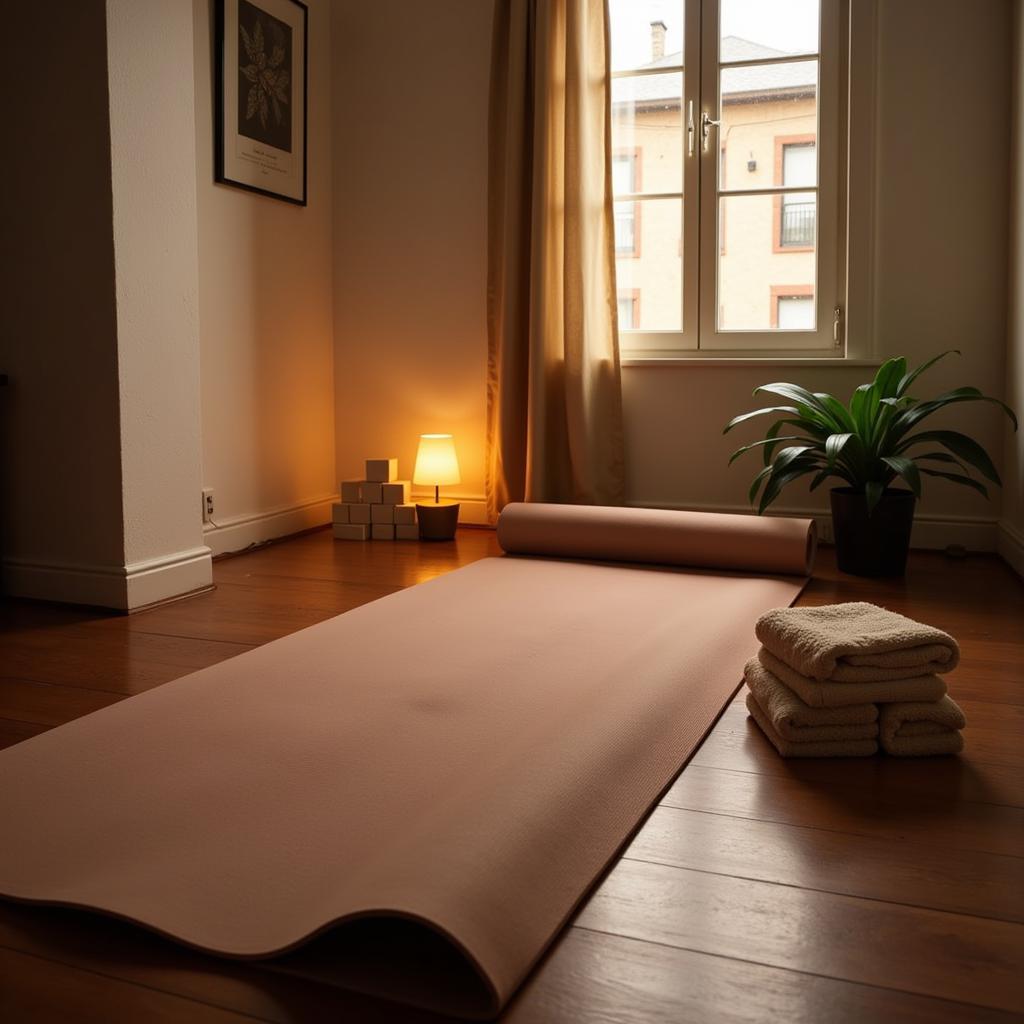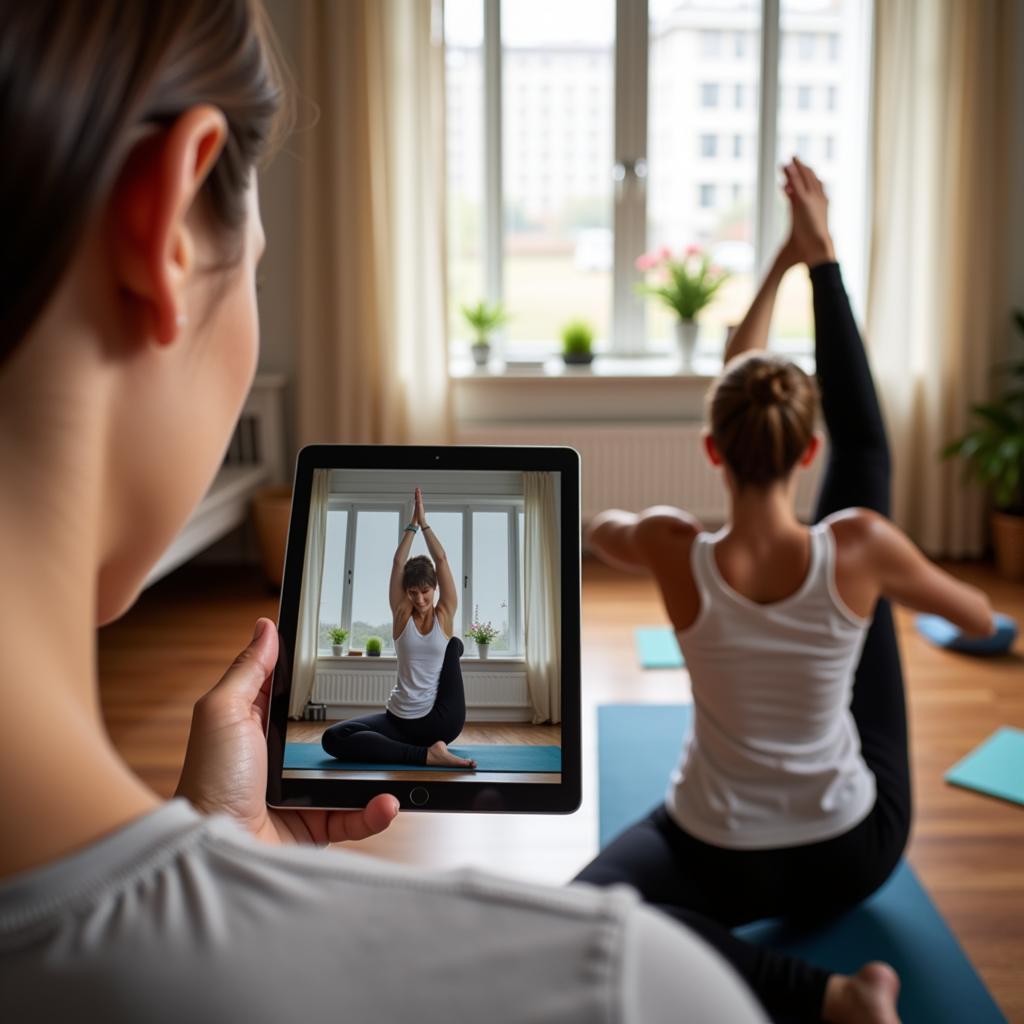Yoga offers a wealth of physical and mental benefits, from increased flexibility and strength to reduced stress and improved sleep. Getting started with a home yoga practice can be easier than you think. This guide will provide you with all the essentials to create your own personal yoga sanctuary and cultivate a regular practice.
Setting the Stage for Your Home Yoga Practice
Creating a dedicated space for your practice can significantly enhance your focus and enjoyment. It doesn’t need to be a large room; a quiet corner will suffice. Consider the following aspects when setting up your home yoga studio:
- Find a Quiet Space: Choose a spot where you can practice undisturbed, free from distractions like phones, televisions, or other interruptions.
- Invest in a Yoga Mat: A good quality yoga mat provides cushioning and grip, crucial for comfortable and safe practice.
- Gather Props: While optional, props like blocks, straps, and blankets can support your postures and deepen your practice.
- Set the Mood: Consider incorporating calming elements like soft lighting, candles, or soothing music to create a relaxing atmosphere.
- Ensure Proper Ventilation: Fresh air is essential for a refreshing practice. Open a window or use a fan for good air circulation.
 Setting up Your Home Yoga Space
Setting up Your Home Yoga Space
Building Your Home Yoga Sequence
A well-structured yoga sequence is key to a fulfilling practice. Here’s a sample sequence for beginners:
- Child’s Pose (Balasana): Start in this restful pose to center yourself and connect with your breath.
- Cat-Cow Pose (Bitilasana Marjaryasana): Gently warm up your spine with these flowing movements.
- Downward-Facing Dog (Adho Mukha Svanasana): Stretch your hamstrings and shoulders while building strength.
- Warrior II Pose (Virabhadrasana II): Strengthen your legs and open your hips.
- Triangle Pose (Trikonasana): Deepen the hip opening and lengthen your side body.
- Tree Pose (Vrksasana): Challenge your balance and focus.
- Seated Forward Fold (Paschimottanasana): Stretch your hamstrings and back.
- Bridge Pose (Setu Bandha Sarvangasana): Open your chest and strengthen your back.
- Savasana (Corpse Pose): Allow your body and mind to completely relax in this final resting pose.
 Beginner Yoga Poses Demonstrated
Beginner Yoga Poses Demonstrated
Finding Online Resources and Guidance
Numerous online resources can further support your home yoga journey:
- Yoga Apps and Websites: Explore platforms like Yoga with Adriene, Glo, or Gaia for guided classes catering to all levels.
- YouTube Channels: Discover free yoga classes on channels dedicated to yoga instruction.
- Online Yoga Communities: Connect with other practitioners in online forums or social media groups for motivation and support.
Tips for Maintaining a Consistent Practice
Consistency is key to reaping the benefits of yoga. Here’s how to stay motivated:
- Schedule Your Practice: Treat your yoga time like any other important appointment.
- Start Small: Begin with shorter sessions and gradually increase the duration as you build strength and stamina.
- Listen to Your Body: Respect your limits and avoid pushing yourself too hard, especially when starting.
- Find an Accountability Partner: Practicing with a friend can boost motivation and keep you on track.
- Celebrate Small Victories: Acknowledge your progress and celebrate each milestone.
“A consistent home yoga practice, even just for a few minutes each day, can transform your overall well-being,” says renowned yoga instructor, Anya Sharma. “It’s not about achieving perfect poses; it’s about connecting with your breath and cultivating self-awareness.”
 Maintaining a Regular Home Yoga Practice
Maintaining a Regular Home Yoga Practice
Conclusion
Establishing a home yoga practice empowers you to prioritize your well-being on your own terms. By creating a dedicated space, building a balanced sequence, and leveraging online resources, you can embark on a rewarding journey of self-discovery and cultivate a healthier, more balanced lifestyle. Start your home yoga practice today and experience the transformative power of yoga.
FAQs
- What if I’m not flexible? Yoga is for everyone, regardless of flexibility. Start slowly and modifications can be made to suit your body.
- What equipment do I need? A yoga mat is essential, while props like blocks and straps can be helpful but are not required.
- How long should I practice? Start with shorter sessions (15-20 minutes) and gradually increase the duration as you feel comfortable.
- What type of yoga is best for beginners? Hatha or Vinyasa yoga are often recommended for beginners.
- Can I practice yoga if I have an injury? Consult with your doctor or physical therapist before starting a yoga practice if you have any injuries.
- What are the benefits of a home yoga practice? Convenience, privacy, and personalized practice are key benefits of practicing at home.
- How do I stay motivated? Set realistic goals, find an accountability partner, and celebrate your progress.
Need support? Contact us at Phone Number: 0372960696, Email: TRAVELCAR[email protected] or visit us at 260 Cau Giay, Hanoi. Our customer service team is available 24/7. We offer 16-seater, 29-seater, and 45-seater vehicle rentals for airport transfers, sightseeing tours, and travel to various tourist destinations. Explore other helpful articles on our website for more wellness and travel tips.

